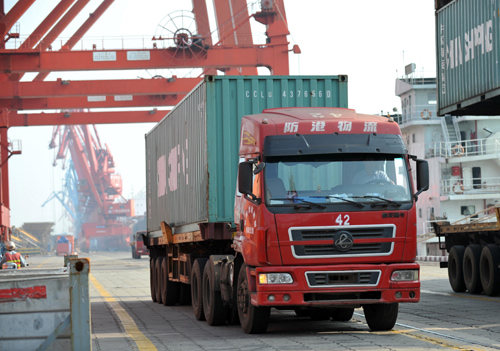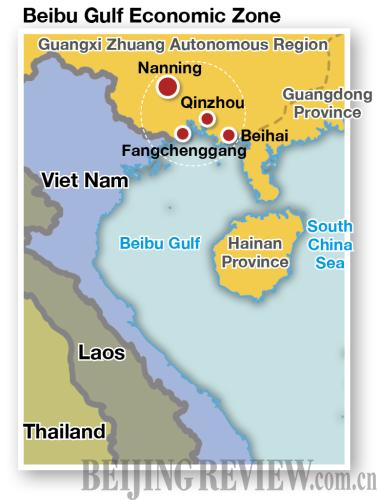|
 |
|
NEW BUSINESS HUB: A truck moves containers at the Fangchenggang Port of Guangxi Zhuang Autonomous Region (LIU GUANGMING) |
"We will invest 15.6 billion yuan ($2.36 billion) to build the railway linking Nanning and Singapore via Viet Nam, which is extremely important for the construction of the Nanning-Singapore Economic Corridor," Long Li, Director of the Transportation Department of the Guangxi Zhuang Autonomous Regional Development and Reform Commission, said.
Zhang Dawei said the Ministry of Railways would give policy preference to the Pan-Beibu Gulf region's economic development.
"The improvement of the current railway systems will ensure steady increases in the transportation volume of vital resources like coal, oil and minerals," he said.
Guangxi has already established 10 direct flight routes to major cities in ASEAN countries. The region vows to open air routes to all major ASEAN cities in the next five years, making Nanning the air gateway to ASEAN.
Bonded areas
To facilitate economic exchanges with the Pan-Beibu Gulf region, the Guangxi Zhuang Autonomous Regional Government has approved several bonded areas, including the Qinzhou Bonded Port Zone, the Pingxiang Comprehensive Bonded Zone, the Nanning Bonded Logistics Center and the Beihai Export Processing Zone.
The Qinzhou Bonded Port Zone, launched in February 2011, is China's sixth and only bonded port on its coast. With a designed area of 10 square km. the first phase of its construction costs 2.82 billion yuan ($433.8 million) and covers 2.5 square km. As the only port that could import assembled automobiles in west China, the zone will import 60,000 cars every year, said Ding Qiwen, Director of Trade Promotion Department of the Qinzhou Bonded Port Zone. According to Ding, import tariffs are not imposed on cars before being sold in domestic market.
The Pingxiang Comprehensive Bonded Zone also has a promising future as a land bridge for import and export between China and ASEAN countries, said Chen Ruixian, Deputy Director of the Beibu Gulf Administration Committee.
The Beihai Export Processing Zone has already formed an industrial cluster focused mainly on processing and manufacturing mechanical and electrical products.
The Nanning Bonded Logistics Center plays a pivotal role in the Guangxi bonded system, which will function as a passageway for economic activity in the China-ASEAN free-trade area that encompasses about 1.9 billion people.
"The establishment of the bonded logistics system in the Beibu Gulf Economic Zone is conducive to the development of Guangxi's bonded logistics system," said Chen. The Beibu Gulf Economic Zone, approved by the Central Government in January 2008, is mainly composed of four cities in Guangxi, namely Nanning, Beihai, Qinzhou and Fangchenggang.
"The system in turn helps shorten the distance between the gulf region and the world. It will also enormously promote the China-ASEAN economic and trade cooperation."
In recent years, the General Administration of Customs (GAC) put promoting Beibu Gulf economic cooperation and development as its key supporting sector, said Sun Qun, Director of Department of Customs Revenue Collection of the GAC.
The GAC will accelerate the establishment of high and convenient supervision system on bonded logistics and clearance system with the information technology, said Sun.
Financial services
Regional cooperation between financial institutions in the Pan-Beibu Golf region became the most discussed issue.
"[Western] central banks use quantitative easing and government backup plans to deal with fundamental problems in their economies. But it is not sustainable. Those developed countries used to interfere with the development of developing countries. I believe it is about time for China and ASEAN to unite to protect their own interests. The Chinese yuan is the best choice for an intermediate currency in trade. I hope China could facilitate a trade mechanism by providing yuan convertibility and develop its settlement mechanism which is easy and simple to implement," said Yum Sui Sang, CEO of Union Commercial Bank of Cambodia.
The yuan settlement in cross-border trade has fared "unexpectedly well" in the past two years, said Zong Liang, Deputy General Manager of the Strategic Development Department of Bank of China, at the forum.
This March, Chinese banking giant Industrial and Commercial Bank of China (ICBC) set up its first overseas yuan processing center in Singapore in line with the bank's strategy to go international and the fast growth of yuan business in the region.
The move showed the bank believed yuan operations in Singapore enjoyed promising prospects, said Wang Lili, Senior Vice President of ICBC.
On June 28, ICBC set up a China-ASEAN yuan clearance and settlement center in Nanning. This center will facilitate trading settlement, inter-bank clearance, and provide supplementary financial services for both Chinese and ASEAN enterprises and banks. ICBC also launched a pilot program for the exchange between the yuan and Vietnamese dong in Nanning.
In spite of the booming banking cooperation in the Pan-Beibu Gulf region, efforts have hit obstacles. According to Yuan Xingyong, Assistant President of the Export-Import Bank of China, four reasons caused a shortage of financial services in region.
First, a limited number of financing instruments have made financing difficult. Second, a lack of a unified and efficient capital clearance system has made transaction costs high. Third, credit information systems in various countries are not unified. Fourth, a regional bond market and cooperation on currency swap is completely missing.
Countries in the Pan-Beibu Gulf region are working to establish a financial platform in order to provide financial support for the area's economic development. For example, Sacombank, one of Viet Nam's leading commercial banks, set up an office in Nanning in 2008. At the same time, Chinese banks are eyeing opportunities in Viet Nam. Major domestic commercial banks, including Bank of Communications, ICBC and China Construction Bank have all set up their branches there.

| 